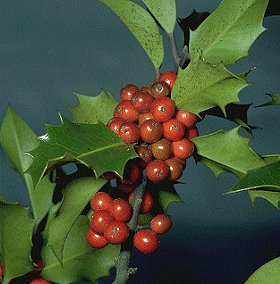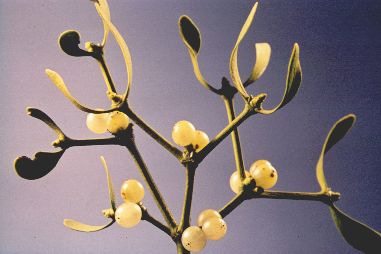The origin of the
Christmas Holly tree
 Christmas
decorations are said to be derived from a custom observed by the Romans of
sending boughs, accompanied by other gifts, to their friends during the
festival of the Saturnalia, a custom the early Christians adopted. In
confirmation of this opinion, a subsequent edict of the Church of Bracara
has been quoted, forbidding Christians to decorate their houses at
Christmas with green boughs at the same time as the pagans, the Saturnalia
commencing about a week before Christmas. The origin has also been traced
to the Druids, who decorated their huts with evergreens during winter as
an abode for the sylvan spirits. In old church calendars we find Christmas
Eve marked templa exornantur (churches are decked), and the custom
is as deeply rooted in modern times as in either pagan or early Christian
days. Christmas
decorations are said to be derived from a custom observed by the Romans of
sending boughs, accompanied by other gifts, to their friends during the
festival of the Saturnalia, a custom the early Christians adopted. In
confirmation of this opinion, a subsequent edict of the Church of Bracara
has been quoted, forbidding Christians to decorate their houses at
Christmas with green boughs at the same time as the pagans, the Saturnalia
commencing about a week before Christmas. The origin has also been traced
to the Druids, who decorated their huts with evergreens during winter as
an abode for the sylvan spirits. In old church calendars we find Christmas
Eve marked templa exornantur (churches are decked), and the custom
is as deeply rooted in modern times as in either pagan or early Christian
days.
An old legend declares
that the Holly first sprang up under the footsteps of Christ, when He trod
the earth, and its thorny leaves and scarlet berries, like drops of blood,
have been thought symbolical of the Saviour's sufferings, for which reason
the tree is called 'Christ's Thorn' in the languages of the northern
countries of Europe. It is, perhaps, in connexion with these legends that
the tree was called the Holy Tree, as it is generally named by our older
writers. Turner, for instance, refers to it by this name in his Herbal
published in 1568. Other popular names for it are Hulver and Holme, and it
is still called Hulver in Norfolk, and Holme in Devon, and Holme Chase in
one part of Dartmoor.
Pliny describes the Holly
under the name of Aquifolius, needle leaf, and adds that it was the
same tree called by Theophrastus Crataegus, but later commentators
deny this. Pliny tells us that Holly if planted near a house or farm,
repelled poison, and defended it from lightning and witchcraft, that the
flowers cause water to freeze, and that the wood, if thrown at any animal,
even without touching it, had the property of compelling the animal to
return and lie down by it.
The origin of the
Christmas Mistletoe
 Mistletoe is one of the Christmas traditions that is pagan with no
Christian symbolism. It belongs to the Viscaceae or
mistletoe family. All members of the family are either parasitic
or hemiparasitic. The Latin word viscusas well as the Greek
word ixias refer to the spermal viscosity of itsberries. These
words are connected with the words visand ischu, which
mean strength. All of the Christmas
mistletoes are hemiparasitic, which means they are only partially
parasitic. They receive a portion of their nourishment by sinking
their roots into the branches or trunk of a a host tree, but they also
contain chlorophyll and can make food by photosynthesis. Traditions of
kissing under the mistletoe go back to the Roman festival of Saturnalia
and kissing under the mistletoe was believed to confer fertility. Many other
cultures, including Celts and Scandinavians, considered the
mistletoe to have magical powers. Probably lending an aura of
mystery to the mistletoe is its method of dispersal. The berries
are eaten by birds and the seeds must pass through the intestines of the
bird before they will germinate. Some have suggested that this
dispersal method led to the name mistletoe which is composed of two Old
English words, "mistel" meaning dung and "tan"
meaning twig. In actuality, the origin of the word mistel
remains a mystery. Mistletoe is one of the Christmas traditions that is pagan with no
Christian symbolism. It belongs to the Viscaceae or
mistletoe family. All members of the family are either parasitic
or hemiparasitic. The Latin word viscusas well as the Greek
word ixias refer to the spermal viscosity of itsberries. These
words are connected with the words visand ischu, which
mean strength. All of the Christmas
mistletoes are hemiparasitic, which means they are only partially
parasitic. They receive a portion of their nourishment by sinking
their roots into the branches or trunk of a a host tree, but they also
contain chlorophyll and can make food by photosynthesis. Traditions of
kissing under the mistletoe go back to the Roman festival of Saturnalia
and kissing under the mistletoe was believed to confer fertility. Many other
cultures, including Celts and Scandinavians, considered the
mistletoe to have magical powers. Probably lending an aura of
mystery to the mistletoe is its method of dispersal. The berries
are eaten by birds and the seeds must pass through the intestines of the
bird before they will germinate. Some have suggested that this
dispersal method led to the name mistletoe which is composed of two Old
English words, "mistel" meaning dung and "tan"
meaning twig. In actuality, the origin of the word mistel
remains a mystery.
The original mistletoe is Viscum album, a European species
that parasitizes a number of different tree species. It has the
traditional white berries associated with mistletoe and can grow into a
moderate sized shrub. It was introduced to California by Luther
Burbank and it may occur in other parts of the US as well. The
more common mistletoes on the US all belong to the genus Phoradendron.
One species, P. tomentosum, is common in Texas and is sold
nationally at Christmas time. Other species, like P. villosum
which grows on oaks, are important locally. The berries of all the
Phoradendron species are also commonly white, but may also be
yellowish or even pink.
|
